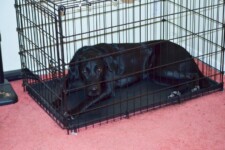Stop Your Dog’s Whining: Fixing Crate Separation Anxiety
As a pet owner, it can be frustrating to hear your dog whine and bark while you’re away from home. Unfortunately, this behavior is not uncommon. Many dogs suffer from separation anxiety when left in a crate.
Separation anxiety can lead to destructive behavior, whining, and barking. These behaviors can be frustrating and disruptive, but they can be prevented or corrected with proper training and patience.
The good news is that there are several steps you can take to help ease your dog’s anxiety and prevent this behavior.
Understanding Crate Separation Anxiety
Crate separation anxiety is a common issue that affects dogs who are placed in a crate for long periods of time or left alone frequently. It occurs because dogs feel separated from their pack, which includes their owner. This can cause a range of negative behaviors such as destructive chewing, digging, and barking.
It is important to note that not all dogs who whine or bark in a crate have separation anxiety. Some dogs may simply be uncomfortable in a small space or may be bored.
To determine if your dog has separation anxiety, look for the following signs:
- Whining, barking, or howling when placed in the crate
- Destructive chewing or digging
- Urination or defecation in the crate
- Escaping from the crate
- Depression or lethargy when you return
Identifying the Causes of Crate Separation Anxiety
To effectively treat crate separation anxiety, it’s crucial to identify the root cause of the problem. This can include:
- Lack of socialization: Dogs who have not been socialized with people, other dogs, and new environments are more likely to experience anxiety when left alone.
- Previous traumatic experiences: Dogs who have been abused, neglected, or abandoned may experience anxiety when left alone in a crate.
- Genetics: Some breeds are more prone to separation anxiety than others, such as Labrador Retrievers, Golden Retrievers, and German Shepherds.
- Change in routine: Sudden changes in routine, such as a new owner, new home, or a change in schedule, can trigger anxiety in dogs.
Techniques for Treating Crate Separation Anxiety
Once you have identified the cause of your dog’s crate separation anxiety, it’s time to start working on a solution. Here are some techniques that can help:
Gradual Acclimation
Gradually increasing the amount of time your dog spends in the crate each day can help them become more comfortable with the space. Start with just a few minutes and gradually increase the time until your dog is comfortable being in the crate for an extended period.
Positive Reinforcement
Reward your dog for calm behavior in the crate with treats and praise. This will help them associate the crate with positive experiences.
Avoid Reinforcing Negative Behaviors
It is important to avoid reinforcing negative behaviors, such as barking or whining, by giving your dog attention or treats. Instead, wait until they are calm and quiet before providing positive reinforcement.
Gradual Desensitization and Counterconditioning
By changing your dog’s emotional response to the crate, you can help them feel more relaxed and calm.
Gradual desensitization and counterconditioning is a technique that involves slowly getting your dog used to being in the crate, while also changing their emotional response to the crate.
This can be done by starting with small increments of time and gradually increasing the amount of time your dog spends in the crate. During this time, provide positive reinforcement such as treats, toys, and praise.
Medication
In severe cases, medication may be necessary to help ease your dog’s anxiety. Consult with a veterinary behaviorist to determine the best course of treatment.
Seek Professional Help
If your dog’s crate separation anxiety is severe, it may be necessary to seek the help of a professional dog behaviorist. A behaviorist can provide a personalized training plan and support to help you and your dog overcome their anxiety.
Working with a professional dog trainer or behaviorist can help you identify the root cause of your dog’s crate separation anxiety and develop a customized treatment plan.
Taking Care of Your Dog’s Physical and Emotional Well-Being
It’s important to remember that treating crate separation anxiety is not a one-time fix. It’s a ongoing process that requires patience, consistency, and dedication.
By taking care of your dog’s physical and emotional well-being, you can help prevent this behavior and ensure that your dog is happy and healthy for years to come.


